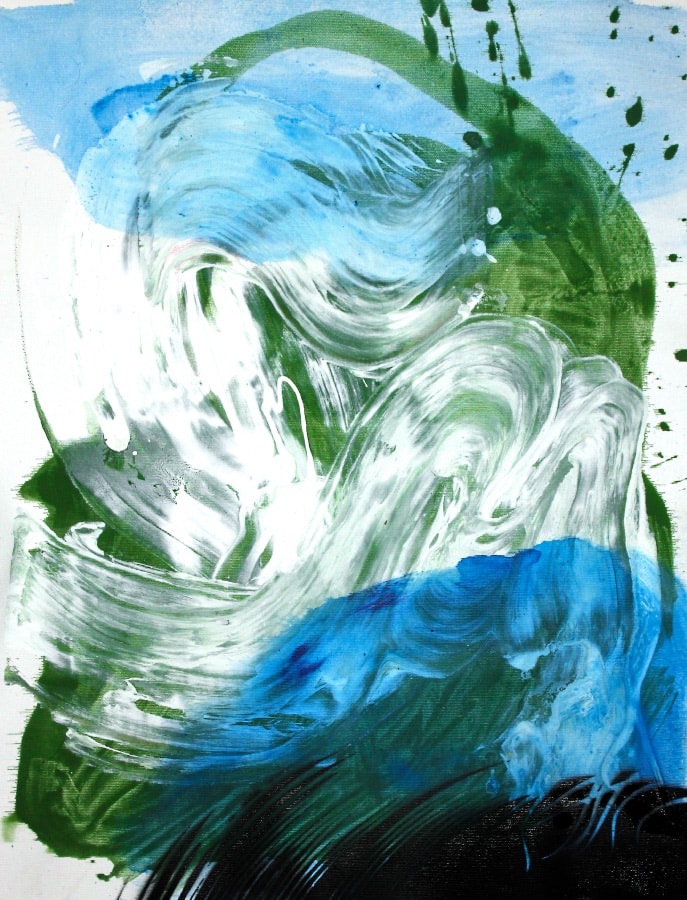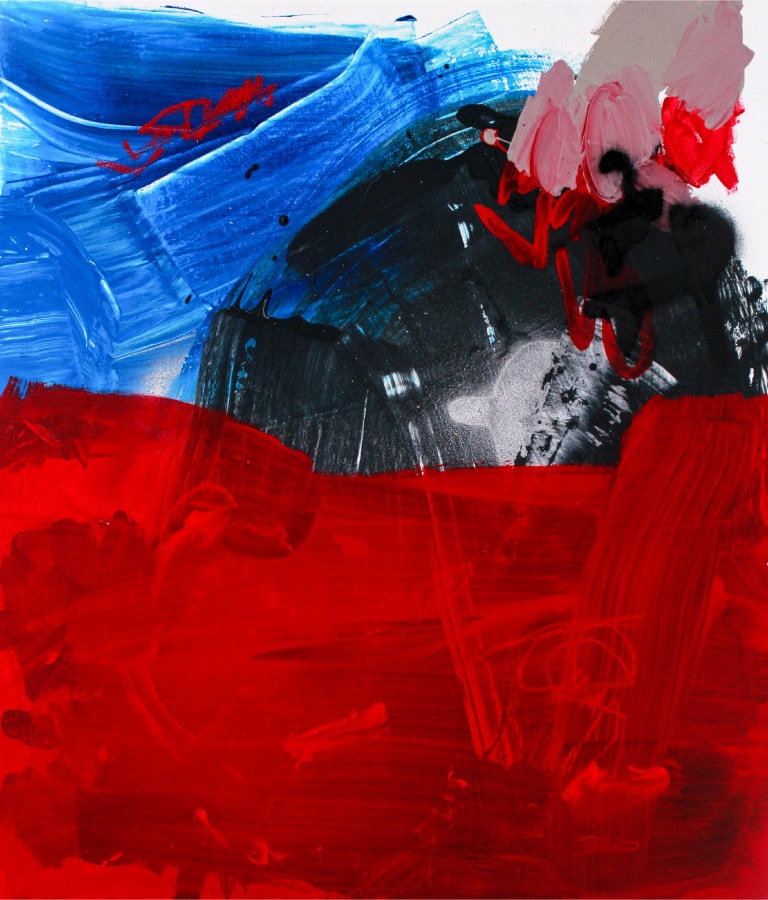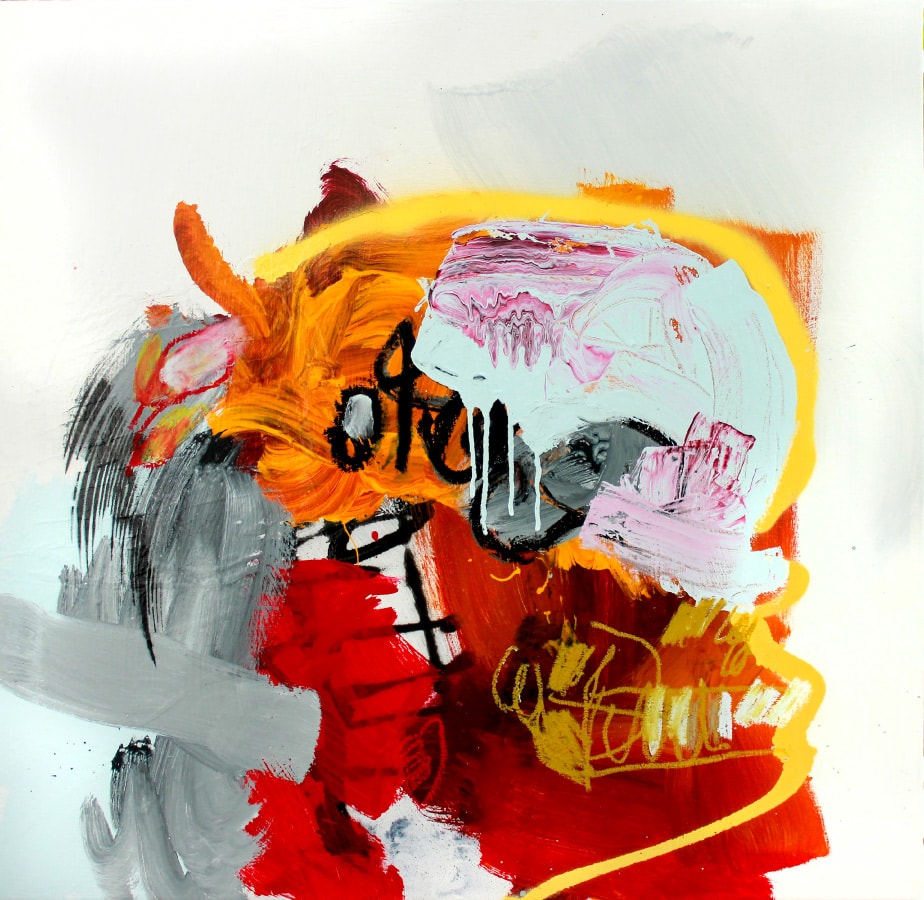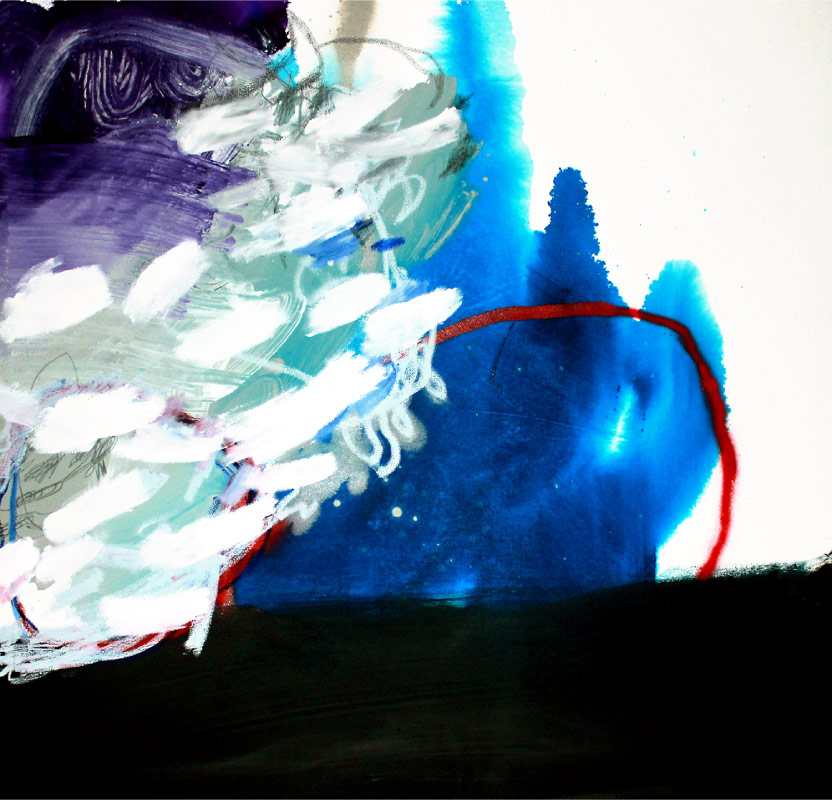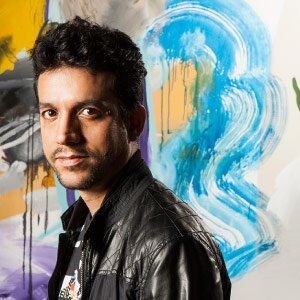
Creating an image is a spontaneous reaction. The behavior of the materials determines the response to continue adding, finalizing the construction process.
Working with figurative images, such as objects or characters, allows me to play between the recognizable form and its abstract environment, confront it to the point of fusion. I stage this form of thing or person, within the abstract context of colors, spellings and it becomes the skin of the form or thing, also in its container box.
The use of different materials and techniques such as spray, crayon, acrylic, collage, stencil allows me to explore the richness of the accident. When I agglomerate the pigments, they give me a starting foot that comes after the patient observation of the first gesture in the painting, the one that points the way to me, the one that invites or rejects the sum of other stains or elements in the work.
In many cases, each painting is visualized as my torso in which the work is developed and composed.
I am attracted by the impulse to compose an image from abstraction, from the use of the stain as the generator of an atmosphere contained by a sequence of unpredictable events.
The overlap of materials allows me to build the work in the form of skins of a body that I can then partially decompose, modify and transform from random impulses.
Juan Henriquez.
USA – Venezuela
About Juan Henriquez
He started his art studies in 1995 at Julio Arraga Art School and then at Neptalí Rincón Superior Art Academy, both in Maracaibo. He continues his studies with experimentation workshops in graphic arts, art restoration, photography, cultural promotion, theater and art direction for cinema, all with great Venezuelan masters.
In his educational experience, he emphasizes his training with his mentor Víctor Fuenmayor, a semiologist, pedagogue and art critic, member of AICA with whom he collaborates and participates in the formation of International Workshops on Pedagogy in Arts, Corporal and Literary Expression during 1998-2002.
He was a co-founder member of La Tintota Art Collective developing public art projects, art labs and collective exhibitions with the support and mentoring of art masters José Ramón Sánchez and Victor Fuenmayor. His work has been shown in national and international art exhibitions, solo art shows, important exhibitions in Belgium, Romania, Brazil, Argentina, Colombia, Peru, the Dutch Caribbean and the United States. In 2002 he received the “Young Artist” award at the 27th National Art Salon of Aragua, Maracay.
He continues his artistic practices with graphic artist and sculptor Maria Bonomi as a collaborator in large-scale public art projects in São Paulo, Brazil. During his residence in Brazil 2004-2006 he took Litography training with the master printer Roberto Gyarf.
Since 2006 he has been living and working in Miami, Florida, where he opens the Art Studio Triphope Gallery together with artist Lisu Vega and is part of the North American cultural scene with participation in collective and individual art projects as well as his active collaboration with VAEA Venezuelan-American Endowment for the Art, New York-Miami.
His most recent project is his mayor solo exhibition “Gozo Solo” at the Museum of Contemporary Art in Zulia, MACZUL, Maracaibo, and in D’Museo at the Los Galpones Art Center, Caracas, Venezuela.
He is currently a represented artist of D’Museo in Caracas-Venezuela participating with them in International Art Fairs such as Art Lima in Peru and Barcú in Colombia.
Click below to download full CV

Reviews
Victor Fuenmayor
International Association of Art Critic Member
June 2016
Rapture of the enjoyment in the look.
With the main title and with each of his works, the artist Juan Henríquez guides us to look at two determinations of creation: solitude and enjoyment. Within the artistic game that brings together creator and spectator, enjoyment introduces the ancient Greek term of aesthesis as a pleasant connector dynamism that gathers the process of emission and reception of the work.
I can translate Greek aesthesis to what contemporary French semiologist Roland Barthes calls “punctum” associating it with a touch that comes to the reader through the signifiers, since it is a fragment of the work that leaves its space towards the viewer to touch or hurt their sensitivity.
This time I am not the one who is going to look for him (…), it is him who comes out of the scene like an arrow and comes to punish me. The punctum (…) is that chance in which it touch me (but that also hurts me, punctures me).
(BARTHES, Roland, 1990, The Lucid Camera, p 64-65).
When I speak of the game I mean the elaboration of the significant form that implies all poetic and artistic action in working with the materiality of languages: lines, colors, energy of the stroke. In this imaginary zone of the pictorial materiality that touches the creator and the spectator, we can highlight a point of union or enjoyment, not obvious, in the works of Juan Henríquez that interweaves between the body, images and signs that we will call “Punctum” of pictorial anagramism – as a game of significant fusion of diverse languages – which can mislead at the beginning, before the reader understands the rules of the game by the author who consciously or unconsciously, establishes connections between the body of enjoyment and visual forms and Literals involving bridges between the linguistic imaginary of letters and pictorial images.
Every joyous act contains its shadow and as you can see by the use of black color (contrasting with celestial, blue, gray, white, red), in the agitations of pictorial gesture to tell us something of that juncture of purity and impurity, sublimation and perversion, which can accommodate the aesthetic space of enjoyment. In those everyday subjects where the artist does not abandon the aesthetic symbolization or forget the more obscure or hidden acts of corporeity, the reader has to release his imagination until he can feel the joy of this diversity of materials, pictorial techniques and that body path of erotic figuration.
A simple illustration of what unites the pictorial signifier of figuration to a desired object and to a desiring body can be seen in The Table whose abstraction leads it to seek meaning in a hybrid figure: drawing a green angle with thick strokes (Table of enjoyment?) and an oval and white shape with a thick point similar to a nipple (oral libido projected to an object?) Green linear corner (maybe the signifier verde warns us of something cornered of the not evident sense that must To see in the linguistic signifier that names color, since it occurs in the forbidden view of enjoyment that that white oval that ends at a point is the term of a breast.
Victor Fuenmayor
International Association of Art Critic Member
June 2005
EQUILIBRIUM IN GAME
The space where Juan Henriquez draws lines and colors is not closed. Cut or open, the strokes give the impression of separation impossible inside-outside edges framed attempt to include a detail of the outside or separate from a figure of an insider. The space becomes something indefinable and elusive, letting the tension between pictorial space and the need to reference or meaning.
There is something unyielding in his personal process. Search the game of materials, colors and spots, free access to meet with some motivating the emergence of space intervened. The figure that emerges expected to outline and give existence since the spot or line. Rising first to drift to find the gesture and the desire of the artist, traces reveal conscious and appeared in the projection images of the game. It reveals, in his strokes, the attempt at dialogue between chance and conscience, imagination and balance disorder linear abstraction and figuration. In some of the works, an allusion or reference guides the way: the Christ of Corcovado and catching a man who flies covered, leaves or feathers or scales, a thread tied to a finger or a line, a man burdened with the patch, clouds, rain and little men on the roof of a house. There are all of them, the freedom of the air or flight and a tie to consciousness.
Revealing chance and conscience, weight and lightness, imaginary play and reference, a sinuous line separates and links two areas of representation. This union of what is proper to separate symbol. The reading can then move toward the symbolic and complementary balance between the pursuit of artistic play and that other thing which espectraliza any patch or line with fragments of reality evoked elliptical. Every symbol points its own court, its missing piece, it must rebuild the reader or viewer. Whatever happens in the preception is based on playing the artist: enjoy free search and find the figure to build their own reference or reading.

